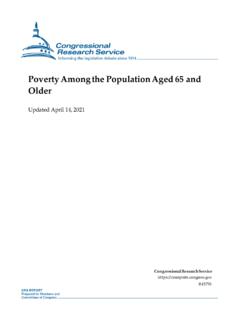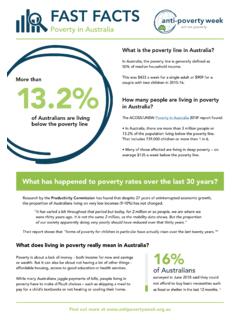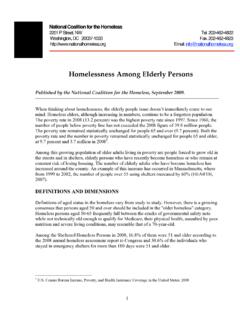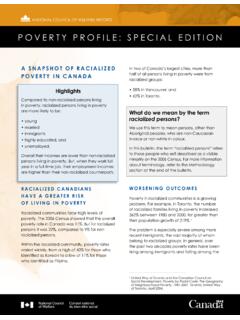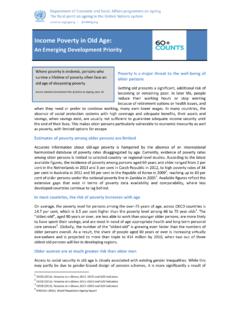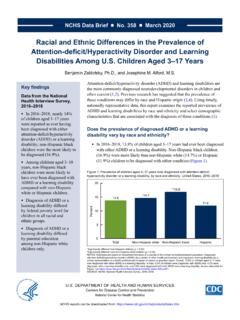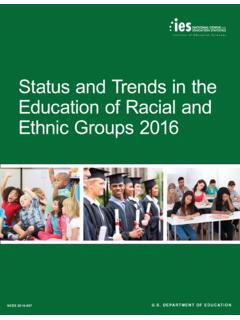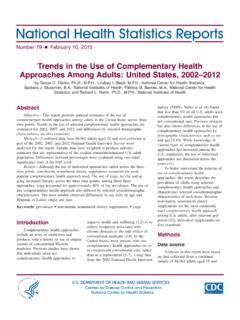Transcription of Government policies to address population ageing
1 population Facts October 2020 | No. 2020/1. Government policies to address population ageing 1. Well-designed policies on population ageing population ageing to be a matter of major policy concern at the present time, and two thirds mark it as a can help to achieve the SDGs concern for the coming decades. This outlook is shared population ageing is a universal phenomenon. Nearly across regions. The proportion of Governments that every country in the world is experiencing growth in considered population ageing to be a major concern both the size and the proportion of older persons in for the next 20 to 30 years was highest in Europe and the population .
2 Currently, there are an estimated 728 Northern America (94 per cent), followed by Eastern and million persons aged 65 years or over in the world. In South-Eastern Asia (88 per cent), Central and Southern the next 30 years, this number is expected to increase Asia (85 per cent), Latin America and the Caribbean (60. to more than double its present value, reaching per cent), sub-Saharan Africa (50 per cent), Australia billion older persons in 2050. The share of the global and New Zealand (50 per cent), and Northern Africa population aged 65 years or over is expected to increase and Western Asia (46 per cent).
3 Among countries that from per cent in 2020 to around per cent in consider population ageing to be a major concern for 2050. The largest increase (+300 million persons) is the next 20 to 30 years, three fourths (38 out of 50) have projected to occur in Eastern and South-Eastern Asia, enacted a national policy on population ageing . from 272 million persons aged 65 years or over in 2020. 3. Common policy measures promote active to 572 million in 2050. Other regions expecting major increases in the number of older persons in the next 30 ageing , lifelong learning and retirement savings years include Central and Southern Asia (+204 million As seen in figure 1, among the fourteen policy measures persons) and Europe and Northern America (+91.)
4 On population ageing listed in the Twelfth Inquiry, million persons). i the three most commonly adopted by Governments As the number and proportion of older persons in the during the past five years were promotion of active world increase, a central question is whether older and healthy ageing (76 per cent), expansion of lifelong people will benefit from improved health and a better learning (66 per cent) and encouragement of private quality of life, as well as social inclusion and income savings (65 per cent). The figure also shows differences security. Policy measures to address population ageing across regions in the policy measures most commonly are critical for achieving the Sustainable Development adopted.
5 Goals (SDGs), in particular for ending poverty in all In countries of Europe and Northern America as well its forms everywhere (SDG 1), ensuring healthy lives as Australia and New Zealand, promoting life-long and promoting well-being for all at all ages (SDG 3), learning and expanding assisted living and age friendly achieving gender equality and empowering all women communities were consistently among the policy and girls (SDG 5), promoting full and productive responses adopted by Governments. In Central and employment and decent work for all (SDG 8), and Southern Asia, preventing abuse and violence against reducing inequalities within and among countries older persons was often listed among the policy (SDG 10).
6 Ii responses to ageing . In countries of Eastern and South- 2. population ageing is a major policy concern for Eastern Asia, addressing discrimination against older persons at work was the most widely adopted policy. the next 20 to 30 years Governments in Latin America and the Caribbean The relevance of population ageing for Government prioritized programmes for older persons that are policies is well documented in the responses provided responsive to the needs of both women and men. In to the Twelfth United Nations Inquiry among Northern Africa and Western Asia, creating schemes Governments on population and Development, which for long-term and institutional care was a common was conducted during One third of the policy response to population ageing .
7 In sub-Saharan Governments with available data (27 out of 81) consider Africa, many Governments prioritized raising the level of pension contributions made by workers. population Facts, No. 2020/1 1. Figure 1. Percentages of Governments, globally and by region, that adopted specific ageing -related policy measures during the five years prior to data collection (roughly 2014-2018). Source: United Nations, Department of Economic and Social Affairs, population Division (2019). Twelfth Inquiry among Governments on population and Development. Note: Figure 1 presents the 14 policy measures on population ageing included in the survey.
8 The grey bars represent global values while the dots represent regional values, based on data from countries that responded to the Twelfth Inquiry. Those countries, grouped by region, were as follows: Australia and New Zealand (Australia/New Zealand); Afghanistan, India, Iran (Islamic Republic of), Kazakhstan, Kyrgyzstan, Maldives, Pakistan, Sri Lanka and Uzbekistan (Central and Southern Asia); Cambodia, Democratic People's Republic of Korea, Japan, Malaysia, Myanmar, Philippines, Thailand and Viet Nam (Eastern and South- Eastern Asia); Belarus, Czechia, Denmark, Finland, Germany, Greece, Latvia, Lithuania, Malta, Republic of Moldova, Romania, Russian Federation, Serbia, Sweden, Switzerland, Ukraine and United Kingdom (Europe and Northern America); El Salvador, Guatemala, Haiti, Honduras and Uruguay (Latin America and the Caribbean); Armenia, Egypt, Georgia, Iraq, Libya, Morocco, Saudi Arabia, State of Palestine, Sudan, Syrian Arab Republic, Tunisia, Turkey and Yemen (Northern Africa and Western Asia).
9 Angola, Botswana, Burkina Faso, Burundi, Cabo Verde, Cameroon, Central African Republic, Chad, Congo, Democratic Republic of the Congo, Equatorial Guinea, Ethiopia, Gabon, Gambia, Guinea, Guinea-Bissau, Liberia, Malawi, Mali, Mauritania, Mauritius, Mozambique, Namibia, Niger, Nigeria, Sao Tome and Principe, Senegal, Sierra Leone, South Africa, South Sudan, Togo and Zambia (sub-Saharan Africa). population Facts, No. 2020/1 2. Figure 2. Percentages of persons aged 65 years or older living independently in countries that did or did not adopt four specific policy measures on the care and living arrangements of older persons during the five years prior to data collection (roughly 2014-2018).
10 Source: United Nations, Department of Economic and Social Affairs, population Division (2019). Twelfth Inquiry among Governments on population and Development, and United Nations, Department of Economic and Social Affairs, population Division (2020). Database on the Households and Living Arrangements of Older Persons 2019. Available at: Note: The dots represent countries that responded to the Twelfth Inquiry. A box-and-whiskers plot depicts the distribution of relevant countries in terms of the percentage of persons aged 65 years or older living independently. For each region, the vertical line inside the box represents the median, and the left and right vertical lines (sides) of the box mark the first and third quartiles (25th and 75th percentiles), respectively, of the distribution.










